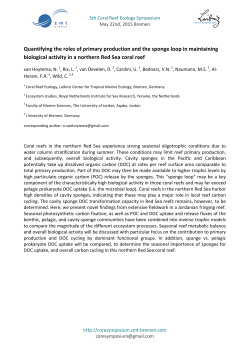
File
Ecology of Sponges Sponges are ideal habitats for marine life because they’re irregular and large. Their relationship with algae, bacteria, and plant like protists is symbiotic; organisms on or inside the sponge provide the food and oxygen for it while the sponge provides protection for the organisms living on or inside it. Although sponges are usually attached to the seafloor, they are able to still absorb direct sunlight. They utilize spicules, like magnifying glasses, to direct incoming sunlight to cells lying beneath the sponge. Below the surface of the sponge, symbiotic organisms are able to carry out photosynthesis. Comparison of Cnidaria to Porifera Sponges are asymmetrical while cnidarians are radially symmetrical. They both have central cavities, but cnidarians have special cells surrounding their central cavity. They both feed intracellularly and use diffusion for circulation, respiration, and excretion. While the sponges have no nervous system, cnidarians have nerve nets and statocysts. Both sponges and cnidarians have the ability to either reproduce sexually or assexually. Cnidarians have specialized cells such as its nerve nets, gastrovascular cavity, and gonads unlike the unspecialized sponge. Comparison of Annelida to Cnidaria T he annelids have have a nervous system like the cnidarians, but have a brain in addition to theirs. They have a digestive system and closed circulatory system unlike any of the other classes before it. The annelids have separate organs that are inside of one organ system. They have bilateral symmetry and segments rather than radial symmetry or no symmetry. Comparison of Mollusca to Annelida Molluscs have gills for respiration instead of using diffusion due to their underwater lifestyle. They have a closed heart in their system because of the water that they filter, and they have a stomach and digestive enzymes because they eat other creatures. They are small and hydrodynamic for moving around freely in the water. They have arms and tentacles for grabbing their prey. They also have a liver for regulating their body temperature with all of the complex organ systems they have to manage rather than the other classes. Comparison of Arthropods to Mollusca The arthropods have a respiratory system that is fully developed instead of using gills or diffusion. They have an open circulatory system unlike the closed system of the mollusca. They both share similar digestive systems. They have a more developed excretory system with malpighian tubes than the mollusca. They have a nervous system with a brain and nerve cord just like the mollusca. They also have organ systems and organs made of tissue that are more developed than the previous phyla.
© Copyright 2025










